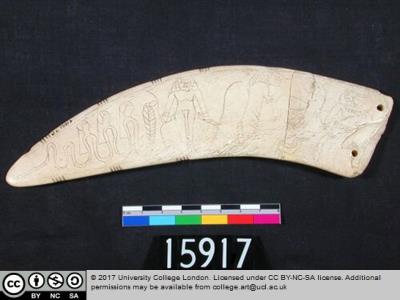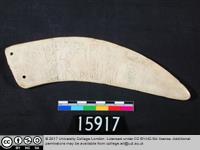- Reproduction
- tusks, amulets
- [nb-NO]Description[nb-NO]Half of smoothed longitudinal central section of a hippopotamus tusk to be wielded in protection of mother and child at birth and in infancy ('birth tusk'), incised with figures on both sides and, on one side, inscribed in hieroglyphs in columns between the figures on one side "words spoken by (figure) we have brought for the protection for the lady of the house Peret, born of Kemeh, protection for the lady of the house Peret". Figures on side with tip at left, from left to right: rearing cobra with five loops, human head at high point of three loops; frontal standing human figure with lion head, holding snake in each hand; standing lion biting at human figure, head severed to upper right; frontal bandy-legged lion-head figure holding snake in each hand. Figures on side with tip at right, from right to left: rearing cobra with three loops; frontal standing figure, body of woman, head of lion (?), holding snake in each hand; standing lion biting at human figure, head severed to upper right; frontal bandy-legged lion-head figure holding snake in each hand. Two holes at break end from ancient repair. Surface cracked; 2 repair holes at end. According to Petrie, Objects of Daily Use, this item was "bought at Thebes in 1882 for Amelia Edwards.
- Thebes
- "Bought at Thebes for Amelia Edwards in 1882" (Petrie, Objects of Daily Use)
- [nb-NO]Documentation[nb-NO]- William Matthew Flinders Petrie, Objects of Daily Use, 42, pl. XXXVII.14
- Drenkhahn, Rosemarie, Elfenbein im Alten Agypten : Leihgaben aus dem Petrie Museum London
- Quirke, Stephen, Birth Tusks: the armoury of health in context - Egypt 1800 BC
- Challis, Debbie, SF Egypt - Time Travel in the Petrie Museum, 10, 12
- Quirke, Stephen, The Tusk of Peret and her Discontents, 225 - late Middle Kingdom
- [nb-NO]Material[nb-NO]
- [nb-NO]Dimensions[nb-NO]
- length: 20 cms
- [nb-NO]Object number[nb-NO]LDUCE-UC15917
- Petrie Museum of Egyptian Archaeology
A nascent retina, generated from a 3D embryonic stem cell culture
|
|













